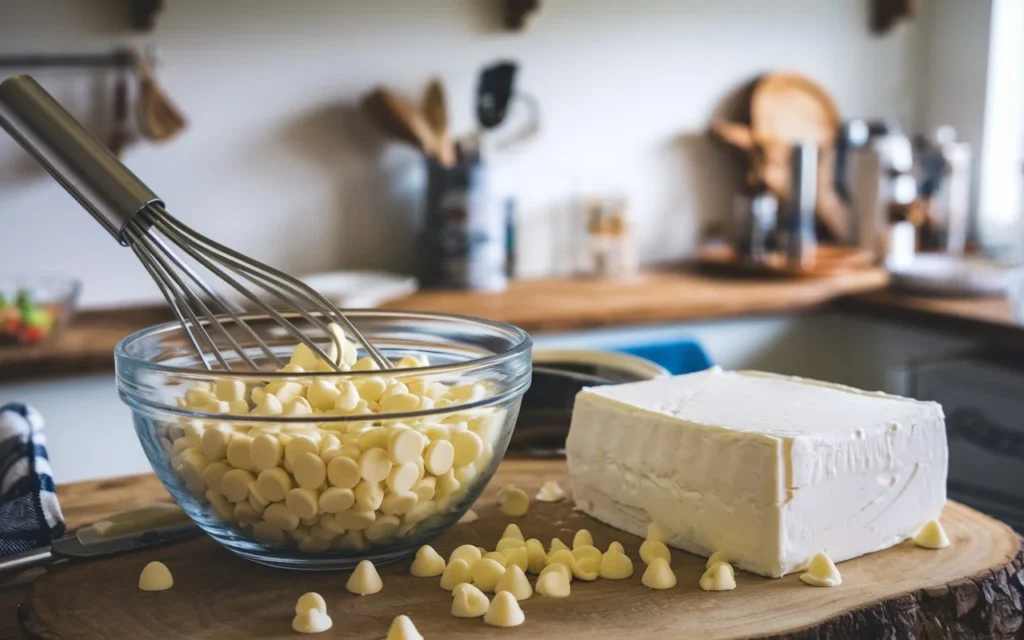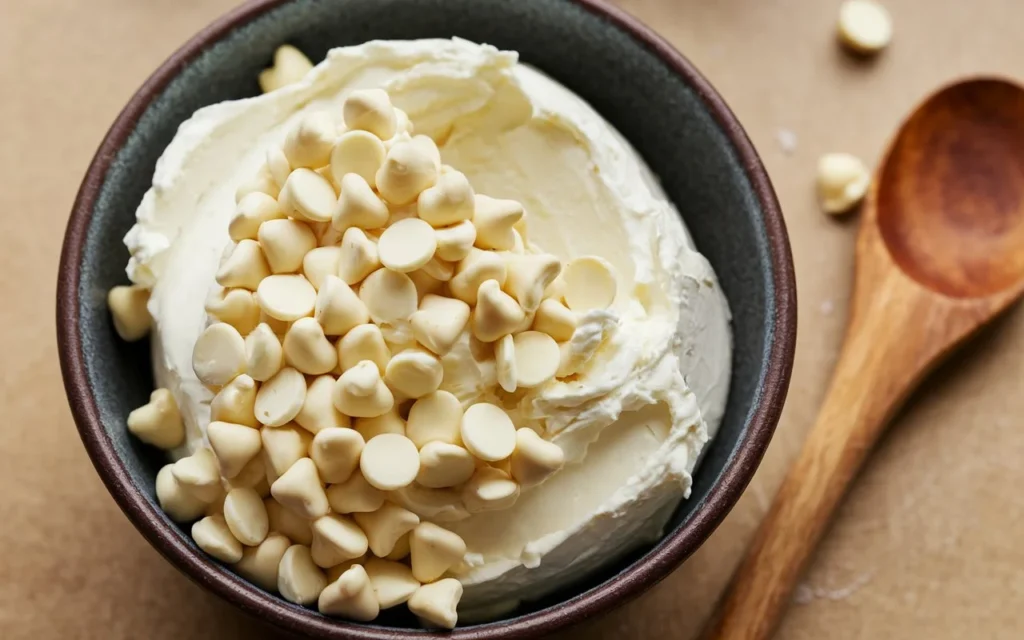Decadent Desserts: Exploring Cream Cheese and White Chocolate
Cream cheese and white chocolate are a match made in dessert heaven! Their rich, creamy textures and delightful sweetness have earned them a place in the hearts of bakers and dessert enthusiasts alike. Whether you’re whipping up a silky frosting, baking a luscious cheesecake, or creating indulgent truffles, these ingredients can elevate your creations to new heights. In this article, we’ll explore their culinary potential, share irresistible recipes, and provide practical tips for storage, health considerations, and more.
Introduction to Cream Cheese and White Chocolate
Understanding Cream Cheese and White Chocolate
Cream cheese is a soft, creamy dairy product with a tangy flavor that adds a velvety texture to dishes. On the other hand, white chocolate, made from cocoa butter, sugar, and milk solids, offers a subtle, sweet taste without the bitterness found in darker chocolates. Combining these ingredients creates a balance of tanginess and sweetness that’s perfect for desserts.
From cheesecakes to frostings, the duo brings unmatched versatility to the kitchen. Cream cheese acts as a stabilizer, ensuring desserts hold their shape, while white chocolate contributes a smooth, rich flavor profile. Together, they’re a staple in many confectionery masterpieces.
Nutritional Profiles
While cream cheese and white chocolate are indulgent, they also offer some nutritional benefits. Cream cheese is rich in calcium and contains small amounts of vitamin A. White chocolate, although higher in sugar, contains cocoa butter, which is a source of antioxidants.
However, they’re best enjoyed in moderation due to their caloric content. Opting for smaller portions or using them in recipes that incorporate fruits or whole grains can help balance indulgence with a bit of health consciousness.
Culinary Uses and Pairings
Both cream cheese and white chocolate are incredibly versatile. Cream cheese is used in savory dishes like dips and spreads, but it truly shines in sweet recipes. White chocolate complements berries, citrus, and nuts, enhancing the overall flavor.
When paired together, they’re the backbone of iconic desserts like cheesecake, cupcakes, and truffles. You can also use them to create unique pairings, such as white chocolate mousse layered with a cream cheese frosting or a marbled brownie combining both elements.
Stay tuned for more recipes and tips to unlock the full potential of this dynamic duo!

Recipes Featuring Cream Cheese and White Chocolate
2.1 White Chocolate Cream Cheese Frosting
When it comes to frosting, nothing beats the creamy, smooth texture of white chocolate cream cheese frosting. This recipe is perfect for topping cupcakes, cakes, or even cookies. The combination of tangy cream cheese and the sweet, velvety taste of white chocolate creates a frosting that’s both indulgent and versatile.
Ingredients:
- 1 cup (8 oz) of softened cream cheese
- 1/2 cup (1 stick) of unsalted butter, softened
- 6 oz of white chocolate, melted and cooled
- 3 cups of powdered sugar
- 1 tsp of vanilla extract
Instructions:
- Begin by melting the white chocolate. Use a double boiler or microwave in 20-second increments, stirring frequently to avoid scorching. Let it cool slightly.
- In a mixing bowl, beat the softened cream cheese and butter until smooth and creamy. This step ensures no lumps in your frosting.
- Gradually pour in the cooled white chocolate, mixing continuously to combine.
- Add the powdered sugar one cup at a time, mixing on low speed to prevent a sugar cloud.
- Stir in the vanilla extract for an added layer of flavor. Beat the frosting until it’s fluffy and holds soft peaks.
Pro Tips:
- Always cool the white chocolate before adding it to avoid curdling the mixture.
- If the frosting seems too soft, chill it in the refrigerator for 10–15 minutes to firm up.
- For added flair, pipe it using a star tip for decorative swirls.
2.2 White Chocolate Cheesecake with Cream Cheese
Few desserts can match the indulgence of a white chocolate cheesecake. The cream cheese lends a creamy tang, while the white chocolate infuses a subtle sweetness that melts in your mouth.
Ingredients for the Crust:
- 1 1/2 cups of graham cracker crumbs
- 1/4 cup of granulated sugar
- 1/2 cup of unsalted butter, melted
Ingredients for the Filling:
- 16 oz of cream cheese, softened
- 1 cup of granulated sugar
- 8 oz of white chocolate, melted and cooled
- 3 large eggs
- 1 tsp of vanilla extract
- 1/2 cup of sour cream
Instructions:
- Prepare the Crust: Mix graham cracker crumbs, sugar, and melted butter in a bowl. Press the mixture firmly into the bottom of a springform pan and refrigerate for 30 minutes.
- Make the Filling: Beat the cream cheese and sugar until smooth and creamy. Slowly add the cooled white chocolate, mixing thoroughly.
- Add eggs one at a time, mixing on low speed after each addition. Stir in vanilla extract and sour cream.
- Pour the filling over the chilled crust, spreading it evenly.
- Bake in a preheated oven at 325°F for about 50–60 minutes or until the center is slightly jiggly.
- Turn off the oven, crack the door, and let the cheesecake cool gradually for an hour. Chill for at least 4 hours before serving.
Tips:
- Garnish with shaved white chocolate or fresh berries for a visual and flavor boost.
- Use a water bath during baking to prevent cracks.
2.3 Cream Cheese and White Chocolate Truffles
These bite-sized delights are ideal for gifting or indulging. The smoothness of cream cheese pairs beautifully with the melt-in-your-mouth sweetness of white chocolate.
Ingredients:
- 8 oz of cream cheese, softened
- 10 oz of white chocolate, melted and cooled
- 1 cup of powdered sugar
- 1/2 tsp of vanilla extract
- Cocoa powder or shredded coconut for coating
Instructions:
- Beat the cream cheese until soft and creamy. Slowly incorporate the melted white chocolate, blending until smooth.
- Add powdered sugar and vanilla extract, mixing until the mixture forms a dough-like consistency.
- Chill the mixture for 1–2 hours until firm enough to roll.
- Scoop small portions and roll them into balls. Coat each truffle in cocoa powder, shredded coconut, or powdered sugar for variety.
- Store in an airtight container in the refrigerator until ready to serve.
Tips:
- To enhance flavor, add a hint of lemon zest or almond extract.
- For extra indulgence, dip the truffles in melted white chocolate before coating.
2.4 White Chocolate Cream Cheese Brownies
Imagine rich, fudgy brownies swirled with white chocolate cream cheese. These brownies are a crowd-pleaser and an instant hit at gatherings.
Ingredients for the Brownie Base:
- 1 cup of unsalted butter, melted
- 2 cups of granulated sugar
- 4 large eggs
- 1 tsp of vanilla extract
- 1 cup of all-purpose flour
- 1/2 cup of cocoa powder
- 1/4 tsp of salt
Ingredients for the Swirl:
- 8 oz of cream cheese, softened
- 4 oz of white chocolate, melted and cooled
- 1/3 cup of granulated sugar
- 1 egg
Instructions:
- Prepare the Brownie Base: Whisk together melted butter, sugar, eggs, and vanilla until smooth. Gradually add flour, cocoa powder, and salt, mixing until well combined. Spread the batter evenly into a greased 9×13-inch pan.
- Make the Swirl: Beat cream cheese, sugar, and egg until smooth. Slowly incorporate the melted white chocolate.
- Drop spoonfuls of the cream cheese mixture onto the brownie batter. Use a knife to swirl the mixtures together gently.
- Bake at 350°F for 30–35 minutes or until a toothpick inserted into the center comes out with moist crumbs.
- Cool completely before cutting into squares.
Tips:
- For an even swirl, don’t overmix the cream cheese layer with the brownie batter.
- Add white chocolate chips to the brownie base for extra texture.
Health Considerations
3.1 Health Benefits of Cream Cheese and White Chocolate
Though indulgent, cream cheese and white chocolate have some surprising benefits when consumed in moderation. These ingredients aren’t just about taste—they can contribute to overall well-being in specific ways.
Calcium and Bone Health:
Cream cheese is a decent source of calcium, a mineral crucial for strong bones and teeth. It also contains small amounts of phosphorus, another important nutrient for skeletal health. Including it occasionally in your diet can help maintain healthy bones, especially when paired with other calcium-rich foods.
Mood Enhancement:
White chocolate, while less rich in cocoa solids than dark chocolate, contains trace amounts of compounds like theobromine and phenylethylamine, which may improve mood and promote feelings of happiness. Its sweetness can also trigger a release of serotonin, the body’s natural “feel-good” chemical.
Energy Boost:
The natural sugars in white chocolate and the fat content in cream cheese provide a quick energy source. For those needing a pick-me-up, a small portion can be a satisfying treat that restores energy levels.
Rich in Flavor, Minimal Quantity:
Because cream cheese and chocolate are intensely flavorful, even a small serving can satisfy cravings, reducing the temptation to overindulge in other high-calorie snacks.
Probiotic Properties:
Cream cheese, like other dairy products, may contain beneficial probiotics that support gut health when derived from cultured sources.
While these benefits make cream cheese and white chocolate appealing, it’s essential to pair them with nutrient-dense ingredients like fruits or nuts for a balanced treat.
3.2 Potential Drawbacks and Moderation
Despite their deliciousness, cream cheese and white chocolate can pose risks if consumed excessively. Being mindful of portion sizes and frequency is key to enjoying these ingredients responsibly.
High Saturated Fat Content:
Cream cheese is high in saturated fats, which can contribute to elevated cholesterol levels and an increased risk of heart disease when consumed in large amounts. Similarly, white chocolate’s cocoa butter adds to its saturated fat content. It’s best to opt for low-fat or reduced-fat cream cheese options whenever possible.
Sugar Overload:
White chocolate is packed with sugar, which, if over-consumed, can lead to issues like weight gain, tooth decay, and even blood sugar spikes. This makes moderation essential, especially for those managing conditions like diabetes.
Caloric Density:
Both cream cheese and white chocolate are calorie-dense, meaning small portions carry a lot of calories. Regularly indulging in large servings can lead to unintended weight gain.
Low Nutrient Density:
While cream cheese offers some nutrients like calcium, its overall nutrient density is lower compared to whole dairy products like yogurt. White chocolate, lacking the flavonoids found in dark chocolate, also offers limited nutritional benefits.
Recommendations for Moderation:
- Use these ingredients as accents rather than the main component of a dish.
- Incorporate them into balanced recipes with fruits, whole grains, or nuts to enhance their nutritional profile.
- Limit consumption to occasional treats, and be conscious of portion sizes.
By enjoying cream and chocolate in moderation, you can savor their flavors without compromising your health.

Frequently Asked Questions
Can I substitute white chocolate with dark chocolate?
Yes, but it will change the flavor and texture. Dark chocolate is more bitter and firm, so you may need to adjust sugar and recipes for balance. Experiment in small batches or blend both chocolates for unique flavors.
How should I store desserts made with cream cheese and white chocolate?
Refrigerate in airtight containers to keep them fresh for 3–5 days. Avoid leaving them at room temperature for more than two hours to prevent spoilage.
Are there dairy-free alternatives for cream cheese and white chocolate?
Yes! Use plant-based cream cheese from cashews or coconut and vegan white chocolate made with cocoa butter. Adjust proportions as these alternatives may differ in consistency.
What is the shelf life of cream cheese and white chocolate?
Opened cream cheese lasts 7–10 days in the fridge, while unopened can last 2–3 weeks past its date. White chocolate can last up to a year when stored in a cool, dry place.
Can I freeze desserts made with cream and white chocolate?
Yes, wrap tightly and freeze in airtight containers. Thaw overnight in the refrigerator for the best texture, avoiding room temperature to prevent condensation.gs and cream cheese-based fillings may require a quick whip after thawing to restore their creaminess.
Conclusion
Cream cheese and white chocolate are a dynamic duo in the world of baking, offering unparalleled versatility and indulgence to a wide array of desserts. This pairing brings together the tangy richness of cream cheese and the sweet, creamy smoothness of chocolate, resulting in a harmonious balance that enhances both flavor and texture. From tangy cheesecakes and velvety frostings to luscious truffles and decadent dessert bars, the combination is a surefire way to elevate ordinary recipes into something extraordinary.
One of the most appealing aspects of cream cheese and white chocolate is their adaptability. These ingredients can be used to create desserts that range from light and airy to rich and indulgent, catering to a variety of palates and occasions. Their ability to complement other flavors, such as fruits, nuts, and spices, further showcases their versatility. Whether it’s a strawberry-topped cheesecake, a zesty lemon cream cheese frosting, or a batch of holiday truffles, these ingredients can transform simple recipes into show-stopping treats.
While enjoying desserts made with cream cheese and white chocolate in moderation is key, they remain staples in any baker’s kitchen for good reason. Their unique qualities not only add indulgence but also open the door to endless creativity, making them indispensable for anyone looking to craft memorable and delicious desserts.








